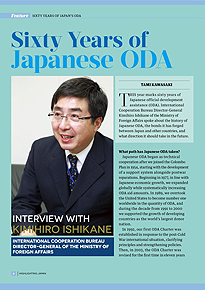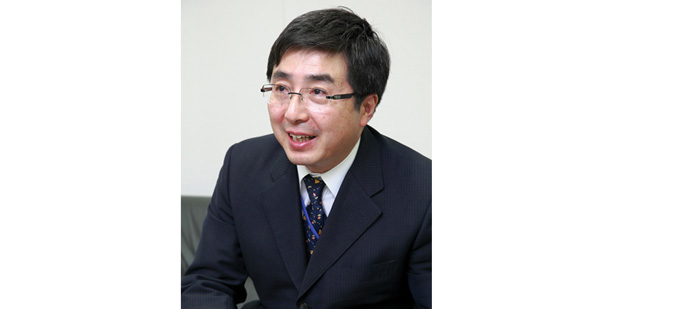Home > Highlighting JAPAN >Highlighting Japan August 2014>Sixty Years of Japanese ODA
Highlighting JAPAN

Sixty Years of Japanese ODA
Interview with Kimihiro Ishikane

This year marks sixty years of Japanese official development assistance (ODA). Kimihiro Ishikane, Director-General, International Cooperation Bureau of the Ministry of Foreign Affairs spoke about the history of Japanese ODA, the bonds it has forged between Japan and other countries, and what direction it should take in the future.
What path has Japanese ODA taken?
Japanese ODA began as technical cooperation after we joined the Colombo Plan in 1954, starting with the development of a support system alongside postwar reparations. Beginning in 1977, in line with Japanese economic growth, we expanded globally while systematically increasing ODA aid amounts. In 1989, we overtook the United States to become number one worldwide in the quantity of ODA, and during the decade from 1991 to 2000 we supported the growth of developing countries as the world's largest donor nation.
In 1992, our first ODA Charter was established in response to the post-Cold War international situation, clarifying principles and strengthening policies. Then, in 2003, the ODA Charter was revised for the first time in eleven years based on changes in the domestic and international circumstances surrounding ODA. Eleven years later, the Charter is again set to be revised to achieve progress toward a new era of ODA.
What are some characteristics of Japanese aid?
Japanese aid includes some consistent convictions. The first is support for self-help efforts. Developing countries will not be able to achieve sustainable growth on their own merely with infrastructure improvements by Japan. It is crucial to nurture local talent and industry alike, which does enable a country to reduce poverty on its own while achieving economic growth. An example of Japan's support for self-help efforts can be seen in the young Japanese people sent all over the world as Japan Overseas Cooperation Volunteers, who join locals in fields such as agriculture and education and teach people while sharing their concerns.
The second is stressing poverty reduction through economic growth. Through Asian infrastructure improvements based on Japanese ODA in the 1960s, Japanese companies expanded into Asia one after the other, resulting in local job creation, promoting consumption and spurring economic growth. Asia and especially the ASEAN region have now become indispensable markets as well as investment destinations for Japan.
Another characteristic is our advocacy of the realization of "human security" and the adoption of thorough, conscientious support methods focusing on every member of the community. I am proud that we have cultivated bonds among people and built up trust toward Japan by protecting individuals from the fear of hunger, crime, disaster and the like while pursuing the happiness of all.
What direction should Japanese ODA take in the future?
The fact that the world is globalizing politically and economically means that development issues will become even more diverse. It is important to expand the scope of traditional ODA and shift toward "development cooperation," which makes it possible to partner with various entities and funds such as governments, local authorities and private companies, and respond to new targets and challenges.
After the Great East Japan Earthquake, Japan received expressions of support from 163 countries and territories as well as 43 international organizations. Some were countries where we provide ODA that, although poor in numerical terms, assisted us with supplies and sent kind messages. I see this, with gratitude, as the return of trusting relations cultivated through ODA.
While cherishing the bonds we have forged with developing countries so far, we hope to open up the horizon for a new era of ODA by sharing the knowledge and experience Japan has cultivated with the international community.
Japanese ODA timeline
1954 – Japan starts ODA upon joining theColombo Plan
1965 – Founding of Japan Overseas Cooperation Volunteers
1974 – Japan International Cooperation Agency (JICA) established
1978 – First medium-term ODA targets announced
1989 – Japanese ODA overtakes US toassume first place
1992 – Enactment of ODA Charter
2003 – ODA Charter revised
2014 – ODA Sixtieth Anniversary
© 2009 Cabinet Office, Government of Japan






